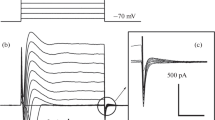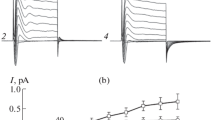Summary
The voltage dependence for outward-going current of the Ca-activated K+ conductance (g k (Ca)) of the human red cell membrane has been examined over a wide range of membrane potentials (V m) at constant values of [K+]ex, [K+]c and pHc, the intact cells being preloaded to different concentrations of ionized calcium. Outward-current conductances were calculated from initial net effluxes of K+ and the corresponding (V m-Ek) values. The basic conductance, defined as the outward-current coductance at (V m-Ek) ≥ 20 mV and [K+]ex ≥ 3mM (B. Vestergaard-Bogind, P. Stampe and P. Christophersen,J. Membrane Biol. 95:121–130, 1987) was found to be a function of cellular ionized Ca. At all degrees of Ca activationg K(Ca) was an apparently linear function of voltage (V m range −40 to +70 mV), the absolute level as well as the slope decreasing with decreasing activation. In a simple two-state model the constant voltage dependence can, at the different degrees of Ca activation, be accounted for by a Boltzmann-type equilibrium function with an equivalent valence of ∼0.4, assuming chemical equilibrium atV m=0 mV. Alternatively, the phenomenon might be explained by a voltage-dependent block of the outward current by an intracellular ion. Superimposed upon the basic conductance is the apparently independent inward-rectifying steep voltage function with an equivalent valence of ∼ 5 and chemical equilibrium at the givenE K value.
Similar content being viewed by others
Abbreviations
- CCCP:
-
carbonyl cyanidem-chlorophenylhydrazone
- DIDS:
-
4,4′-diisothiocyanostilbene-2,2′-disul
References
Bennekou, P. 1984. K+-valinomycin and chloride conductance of the human red cell membrane. Influence of the membrane protonophore carbonylcyanidm-chlorophenylhydrazone.Biochim. Biophys. Acta 776:1–9
Cabantchick, Z.I., Rothstein, A. 1974. Membrane proteins related to anion permeability of human red blood cells. I. Localization of disulfonic stibene binding sites in proteins involved in permeation.J. Membrane Biol. 15:207–226
Christophersen, P., Bennekou, P. 1987. Mg++ affects the singlechannel conductance of the human red cell K+-channel, but not rectification.Acta Physiol. Scand. (In press)
Grygorczyk, R., Schwarz, W. 1983. Properties of the Ca2+-activated K+ conductance of human red cells as revealed by the patch-clamp technique.Cell Calcium 4:499–510
Grygorczyk, R., Schwarz, W. 1985. Ca2+-activated K+ permeability in human erythrocytes: Modulation of single-channel events.Eur. Biophys. J. 12:57–65
Grygorczyk, R., Schwarz, W., Passow, H. 1984. Ca2+-activated K+ channels in human red cells.Biophys. J. 45:693–698
Hamill, O.P. 1981. Potassium channel currents in human red blood cells.J. Physiol. (London) 319:97P-98P
Hille, B. 1984. Ionic Channels of Excitable Membranes. p. 109. ff. Sinauer Associates, Sunderland, Mass.
Hodgkin, A.L., Huxley, A.F. 1952a. Currents carried by sodium and potassium ions through the membrane of the giant axon ofLoligo.J. Physiol. (London) 116:449–472
Hodgkin, A.L., Huxley, A.F. 1952b. A quantitative description of membrane current and its application to conduction and excitation in nerve.J. Physiol. (London) 117:500–544
Hodgkin, A.L., Keynes, R.D. 1955. The potassium permeability of a giant nerve fibre.J. Physiol. (London) 128:61–88
Jones, G.S., Knauf, P.A. 1985. Mechanism of the increase in cation permeability of human erythrocytes in low-chloride media.J. Gen. Physiol. 86:721–738
Macey, R.I., Adorante, J.S., Orme, F.W. 1978. Erythrocyte membrane potentials determined by hydrogen ion distribution.Biochim. Biophys. Acta 512:284–295
Stampe, P., Vestergaard-Bogind, B. 1985. The Ca2+-sensitive K+-conductance of the human red cell membrane is strongly dependent on cellular pH.Biochim. Biophys. Acta 815:313–321
Vestergaard-Bogind, B., Stampe, P. 1984. Trans to cis proton concentration gradients accelerate ionophore A23187-mediated net fluxes of Ca2+ across the human red cell membrane.Biochim. Biophys. Acta 775:328–340
Vestergaard-Bogind, B., Stampe, P., Christophersen, P. 1985 Single-file diffusion through the Ca2+-activated K+ channel of human red cells.J. Membrane Biol. 88:67–75
Vestergaard-Bogind, B., Stampe, P., Christophersen, P. 1987. Voltage dependence of the Ca2+-activated K+ conductance of human red cell membranes is strongly dependent on extracellular K+ concentration.J. Membrane Biol. 95:121–130
Yingst, D.R., Hoffman, J.F. 1984. Ca-induced K transport in human red blood cell ghosts containing Arzenazo III.J. Gen. Physiol. 83:19–45
Author information
Authors and Affiliations
Rights and permissions
About this article
Cite this article
Stampe, P., Vestergaard-Bogind, B. Ca2+-activated K+ conductance of human red cell membranes exhibits two different types of voltage dependence. J. Membrain Biol. 101, 165–172 (1988). https://doi.org/10.1007/BF01872831
Received:
Revised:
Issue Date:
DOI: https://doi.org/10.1007/BF01872831




